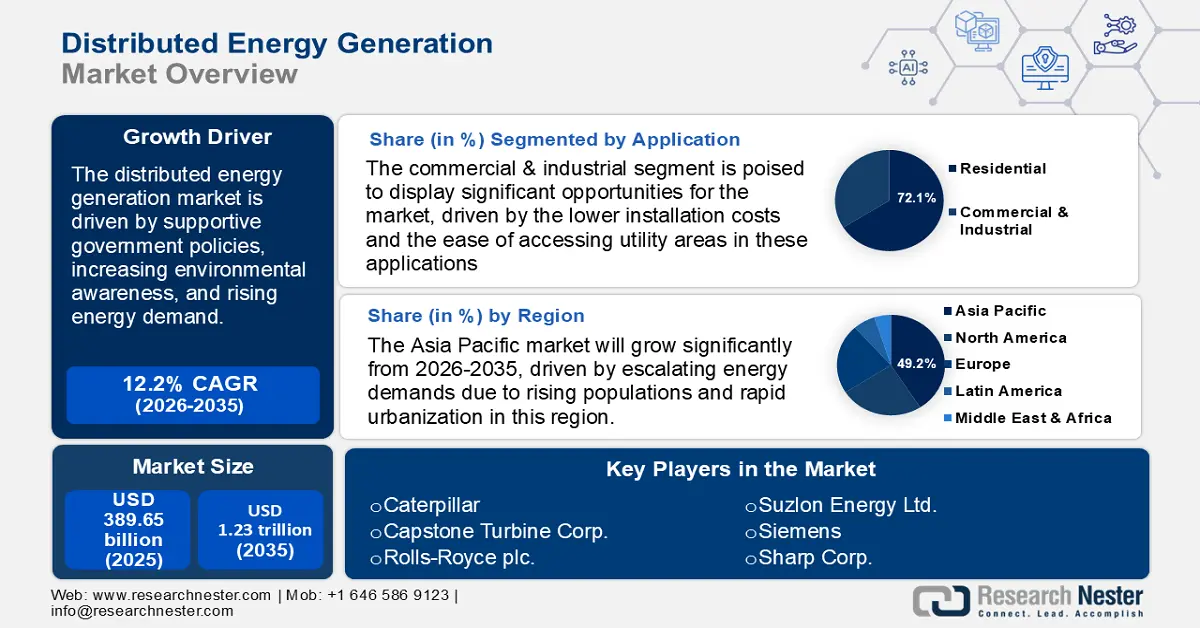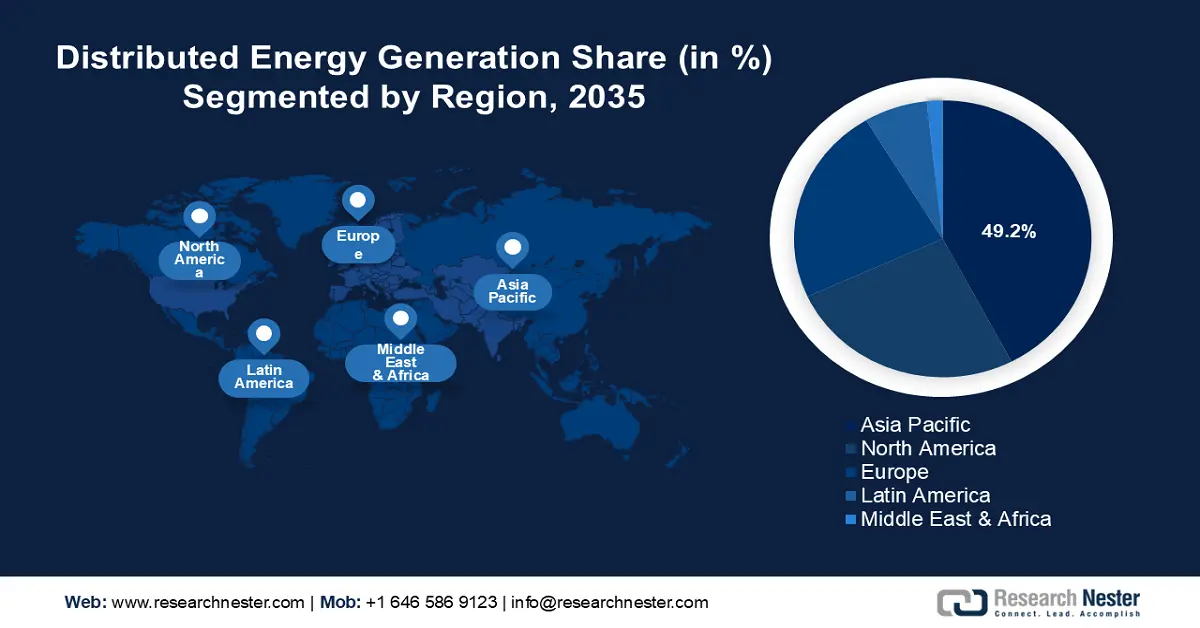Distributed Enterprise Market Outlook:
Distributed Enterprise Market size was over USD 7.99 billion in 2025 and is projected to reach USD 20.54 billion by 2035, growing at around 9.9% CAGR during the forecast period i.e., between 2026-2035. In the year 2026, the industry size of distributed enterprise is evaluated at USD 8.7 billion.

Many organizations across the globe are adopting remote and hybrid work models that are increasing the necessity for integrated communication solutions. Applications, including Microsoft Teams and Zoom, are offering advanced features, such as AI-transcription functionality. This merges with video meeting options and cloud tools for enhanced productivity and immediate global operational decision-making capabilities, fueling distributed enterprise market growth. So, organizations are using collaboration technologies for secure, scalable, and flexible communication, enabling employees to work efficiently regardless of their physical location.
Industry giants such as Microsoft Corporation and VMWare Inc. leverage unified communications and collaboration (UC&C) solutions to allow seamless internal communication among dispersed teams. Several companies are focused on introducing AI-powered innovations in UC&C platforms to generate smart meeting reports while translating languages in real time and presenting contextual insights about meetings and their effects on workflow performance. For instance, in January 2025, Wildix launched AI-based WMS 7 to assist partners in their changing workplace environments. The new system integrates automation with smart collaboration tools to optimize communication for remote teams.
Key Distributed Enterprise Market Insights Summary:
Regional Highlights:
- Asia Pacific commands the Distributed Enterprise Market with a 40.8% share, propelled by increasing adoption of hybrid work models, enhancing its dominance through flexible work solutions during 2026–2035.
- North America is expected to achieve significant growth in the Distributed Enterprise Market from 2026 to 2035, driven by rising demand for zero-trust security and cloud-native solutions.
Segment Insights:
- The remote workforce segment is expected to exhibit steady growth through 2035, propelled by the rising adoption of AI tools and data analytics for remote collaboration.
- The Cloud segment of the Distributed Enterprise Market is projected to achieve a 64.40% share from 2026 to 2035, driven by strong investments in AI-enhanced cloud infrastructure and sector-specific solutions.
Key Growth Trends:
- Focus on digital twin technology
- Integration of decentralized finance and blockchain
Major Challenges:
- Connectivity and network reliability issues
- Employee productivity and collaboration barriers
- Key Players: Cisco Systems, Inc., VMWare, Inc., Citrix Systems, Inc., and Hewlett Packard Enterprise Company.
Global Distributed Enterprise Market Forecast and Regional Outlook:
Market Size & Growth Projections:
- 2025 Market Size: USD 7.99 billion
- 2026 Market Size: USD 8.7 billion
- Projected Market Size: USD 20.54 billion by 2035
- Growth Forecasts: 9.9% CAGR (2026-2035)
Key Regional Dynamics:
- Largest Region: Asia Pacific (40.8% Share by 2035)
- Fastest Growing Region: Asia Pacific
- Dominating Countries: United States, China, Germany, Japan, UK
- Emerging Countries: China, Japan, South Korea, India, Singapore
Last updated on : 12 August, 2025
Distributed Enterprise Market Growth Drivers and Challenges:
Growth Drivers
- Focus on digital twin technology: Several industries are leveraging digital twin technology for processes such as supply chain, manufacturing, and infrastructure management. Digital twins based on distributed enterprises are enabling remote observation of equipment, predictive breakdown prevention, and immediate operational choices, improving system reliability and cutting operational interruptions. Accurate virtual models enable organizations to conduct simulations while predicting system failures before they occur and optimizing operational procedures without interrupting current project management processes. Through this forward-looking method, organizations are initiating necessary interventions and enhancing their operations in line with current industry requirements.
Organizations are indulging in strategic partnerships to integrate advanced technologies into the digital twin technology and to boost user experience along with operational efficiency. For instance, in February 2025, Dassault Systèmes collaborated with Apple to integrate its industrial 3Dare software into Apple's Vision Pro device. With this collaboration, the organizations are aimed at offering 3DLive as their new app, providing advanced digital twin functionality for real-time mutually-remote model collaboration. Through its integration, Apple is deploying advanced computing features and sensor technology to help engineers and designers find and solve manufacturing problems before major process milestones, resulting in saving time and costs.
- Integration of decentralized finance and blockchain: The integration of blockchain technology with decentralized finance (DeFi) is driving transformative changes to distributed enterprises operating in finance sectors, supply chains, and logistical operations. Smart contracts built on blockchain technology allow enterprises to optimize their operations by reducing reliance on intermediaries and enhancing digital transaction transparency. Through DeFi platforms, users perform automated secure financial operations, transcending the banking limitations to maximize payment speed while managing digital assets.
The accelerating adoption of blockchain is driving businesses to implement distributed ledger technology as it improves trust, security features, and trackable processes. For instance, in November 2023, JPMorgan joined forces with the Monetary Authority of Singapore to complete a cross-border transaction project relying on blockchain technology and DeFi protocols. The program established a system using smart contracts and decentralized applications (dApps) to enhance international trade finance transaction efficiency while providing secure operations.
Challenges
-
Connectivity and network reliability issues: For a distributed enterprise, operation stability and high-speed internet connectivity are required to enable smooth functions, seamless teamwork, and cloud application accessibility. Different regions may face major problems due to a lack of equal or standardized network infrastructure. Poor performance in remote areas may cause reduction in system bandwidth, resulting in constant interruptions as well as delays for real-time communication and workflow effectiveness. The operational difficulties experienced by businesses in these areas, including problems with videoconferencing lags and data synchronization issues, may restrict access to essential applications, thus reducing productivity and prolonging crucial decision waits.
-
Employee productivity and collaboration barriers: The distributed enterprise is experiencing difficulties while trying to preserve employee productivity and seamless team collaboration across all distribution sites. Challenges, including differences in time zones, communication gaps, and lack of in-person interactions, can restrain teamwork, leading to slow decision-making. This can hamper work engagement and operational alignment as workers lack access to company-wide resources through inconsistent work patterns.
Distributed Enterprise Market Size and Forecast:
| Report Attribute | Details |
|---|---|
|
Base Year |
2025 |
|
Forecast Period |
2026-2035 |
|
CAGR |
9.9% |
|
Base Year Market Size (2025) |
USD 7.99 billion |
|
Forecast Year Market Size (2035) |
USD 20.54 billion |
|
Regional Scope |
|
Distributed Enterprise Market Segmentation:
Deployment Mode (Cloud, On-Premise)
Cloud segment is expected to hold over 64.4% distributed enterprise market share by the end of 2035, owing to the significant investments in AI-driven cloud infrastructure by companies. For instance, in March 2025, Oracle provided optimistic long-term projections, predicting their revenue growth by 15% in FY2026, attributed to intensive AI computational requirements. The company is planning to expand its data center facilities by two times as part of its efforts to deliver AI-enhanced cloud service offerings. AI integration also plays an essential part in developing cloud infrastructure systems, driving distributed enterprises toward greater expansion while improving their operational performance.
The segment is also expected to grow, owing to the rising customer requirements for sector-specific cloud services. Organizations in the healthcare, finance, and manufacturing sectors are increasingly adopting custom cloud infrastructure systems, fulfilling their specific operational requirements, regulatory frameworks, and security needs. Specialized solutions from cloud providers are offering strengthened compliance, improved data security, and optimized workflow capabilities.
Type (Branch Offices, Retail Chains, Franchise Businesses, Manufacturing Facilities, Remote Workforce, Global Enterprises, Cloud-based Infrastructure, Service Providers)
The remote workforce segment in distributed enterprise market is expected to witness steady growth due to organizational deployments of complex collaboration platforms and employee communication technology tools. Businesses are adopting integrated analytics systems equipped to deliver instant performance, communication effectiveness, and employee engagement data. These solutions enable leadership teams to find productivity obstacles so they can develop approaches for better collaboration. Modern organizations are using data analytics to refine remote work practices while improving worker connection, thus establishing critical tools for distributed team management.
Remotely integrated AI and various advanced technologies are enhancing work efficiency, and driving rapid expansion of the segment. Companies are deploying AI tools to facilitate efficient remote team communication while the tools are automating standard work processes and generating valuable data analytics to help teams work productively from remote locations and collaborate effectively. For instance, in September 2023, Remote introduced its Global HR Platform as a global system for distributed workforce assistance. The platform comprises AI-enabled features, talent management systems, and expense management functionalities, which can be found in a unified platform.
Our in-depth analysis of the global distributed enterprise market includes the following segments:
|
Type |
|
|
Deployment Mode |
|
|
Vertical |
|

Vishnu Nair
Head - Global Business DevelopmentCustomize this report to your requirements — connect with our consultant for personalized insights and options.
Distributed Enterprise Market Regional Analysis:
Asia Pacific Market Analysis
Asia Pacific distributed enterprise market is set to account for revenue share of around 40.8% by 2035, owing to increasing adoption of hybrid work models. Organizations from various industries in the region are moving toward hybrid work models through remote work arrangements, generating an increased need for cloud-based collaboration tools, secure network solutions, and distributed computing infrastructure.
Distributed teams in the region are receiving real-time data access through cloud computing networks alongside edge computing solutions through new investments from companies that focus on seamless connectivity. Advanced connectivity solutions combined with 5G network expansion are essential drivers that are accelerating distributed enterprise market growth in the region. High-speed, low-latency 5G infrastructure deployment allows enterprises to advance their digital transformation work along with operation optimization and the handling of data-intensive programs. The improved connectivity enables the region’s distributed enterprise environments to be more innovative for business expansion.
The China distributed enterprise market is experiencing steady growth, owing to the rapid expansion of edge computing in the country. Reductions in real-time data processing times are driving enterprises to deploy edge computing solutions. This transformation is making organizations less dependent on central cloud infrastructure while improving data protection and decreasing the response times of vital applications. Smart manufacturing, as well as logistics and autonomous transportation industries in China, are continuing their rapid implementation of edge computing solutions to enhance operational efficiency.
The distributed enterprise market in India is highlighting a steady expansion, owing to the local government’s Production-Linked Incentive scheme, introduced in April 2020, to reduce import dependency and support domestic manufacturing. According to a report from the Press Information Bureau, for the financial year 2025-2026, the PLI scheme for electronics manufacturing attracted cumulative investments of nearly USD 1.0 billion. This substantial growth underscores India's emergence as a significant player in the global electronics supply chain. The increasing role of private companies in aerospace and defense manufacturing is also propelling the country’s market growth.
North America Market
The distributed enterprise market in North America is expected to witness a significant expansion during the forecast period, attributed to the rising demand for zero-trust security architecture. Organizations in the region adopting hybrid and remote work models are increasingly requiring more secure features compared to traditional perimeter-based security. The demand for sensitive data security is essential for banking sectors, healthcare facilities, and governmental institutions. The distributed enterprise market is also experiencing an accelerated expansion, owing to growing cloud-native solution implementations. Businesses are adopting multi-cloud as well as hybrid-cloud models as strategic choices for maintaining operational continuity with scalability attributes.
The distributed enterprise market in the U.S. is anticipated to increase at a fast pace due to strong government initiatives supporting the development of digital infrastructure alongside cybersecurity resilience measures. For instance, the CHIPS and Science Act (2022 enactment), together with the National Cybersecurity Strategy (2023), is driving businesses to invest in advanced networking, cloud computing, and secure data management capabilities to operate across multiple sites.
The government is also investing in secured high-performance digital platforms, enabling remote business operations without interruption. The shift toward improving hybrid workforce optimization is prompting enterprises in the country to invest in advanced collaboration tools and digital workspaces. As companies are adopting hybrid and remote work models, they are using AI-powered communication solutions, virtual desktop infrastructure, and cloud-based workflow tools for seamless connections between digital and physical operations.
The distributed enterprise market in Canada is witnessing steady growth, owing to the local government initiatives to enhance digital network investments. The public as well as private enterprises are investing in projects to develop smart cities and IoT-enabled infrastructure, accelerating distributed enterprise development in the country. The implementation of IoT-connected devices is allowing organizations to enhance logistics activities, energy monitoring systems, and remote oversight, allowing them to operate seamlessly across multiple locations. The rapid adoption of IoT technology is enabling enterprises to achieve better real-time operations and improved workforce mobility for a distributed network.

Key Distributed Enterprise Market Players:
- Cisco Systems, Inc.
- Company Overview
- Business Strategy
- Key Technology Offerings
- Financial Performance
- Key Performance Indicators
- Risk Analysis
- Recent Development
- Regional Presence
- SWOT Analysis
- VMware, Inc.
- Citrix Systems, Inc.
- Hewlett Packard Enterprise Company
- Microsoft Corporation
- Dell Technologies Inc.
- Fortinet, Inc.
- Palo Alto Networks, Inc.
- Juniper Networks, Inc.
- Aruba Networks
- Riverbed Technology, Inc.
- Silver Peak Systems, Inc.
- Extreme Networks, Inc.
- Aryaka Networks, Inc.
- CloudGenix, Inc.
The competitive landscape of the distributed enterprise market is rapidly evolving, attributed to the integration of advanced technologies such as AI and IoT in the industry by key players. They are focused on developing new strategies catering to the stringent regulatory norms and consumer demand. These key players are adopting several strategies, such as mergers and acquisitions, joint ventures, partnerships, and novel technology launches, to enhance their base and strengthen their market position. Here are some key players operating in the global distributed enterprise market:
Recent Developments
- In March 2025, ServiceNow announced the acquisition of AI startup Moveworks for USD 2.85 billion, marking its largest acquisition to date. Moveworks, known for its generative AI assistant for employee support, is expected to help ServiceNow enhance its customer service management products by integrating advanced AI capabilities.
- In July 2024, Google launched air-gapped Distributed Cloud Edge hardware designed to support AI workloads securely in on-premises environments. This solution allows organizations to run sensitive AI applications with enhanced security by isolating workloads from external networks, catering to industries with strict data privacy requirements.
- Report ID: 7351
- Published Date: Aug 12, 2025
- Report Format: PDF, PPT
- Get detailed insights on specific segments/region
- Inquire about report customization for your industry
- Learn about our special pricing for startups
- Request a demo of the report’s key findings
- Understand the report’s forecasting methodology
- Inquire about post-purchase support and updates
- Ask About Company-Level Intelligence Additions
Have specific data needs or budget constraints?
Frequently Asked Questions (FAQ)
Distributed Enterprise Market Report Scope
FREE Sample Copy includes market overview, growth trends, statistical charts & tables, forecast estimates, and much more.
Connect with our Expert
See how top U.S. companies are managing market uncertainty — get your free sample with trends, challenges, macroeconomic factors, charts, forecasts, and more.
Copyright @ 2025 Research Nester. All Rights Reserved.

 Inquiry Before Buying
Inquiry Before Buying


 Afghanistan (+93)
Afghanistan (+93)
 Åland Islands (+358)
Åland Islands (+358)
 Albania (+355)
Albania (+355)
 Algeria (+213)
Algeria (+213)
 American Samoa (+1684)
American Samoa (+1684)
 Andorra (+376)
Andorra (+376)
 Angola (+244)
Angola (+244)
 Anguilla (+1264)
Anguilla (+1264)
 Antarctica (+672)
Antarctica (+672)
 Antigua and Barbuda (+1268)
Antigua and Barbuda (+1268)
 Argentina (+54)
Argentina (+54)
 Armenia (+374)
Armenia (+374)
 Aruba (+297)
Aruba (+297)
 Australia (+61)
Australia (+61)
 Austria (+43)
Austria (+43)
 Azerbaijan (+994)
Azerbaijan (+994)
 Bahamas (+1242)
Bahamas (+1242)
 Bahrain (+973)
Bahrain (+973)
 Bangladesh (+880)
Bangladesh (+880)
 Barbados (+1246)
Barbados (+1246)
 Belarus (+375)
Belarus (+375)
 Belgium (+32)
Belgium (+32)
 Belize (+501)
Belize (+501)
 Benin (+229)
Benin (+229)
 Bermuda (+1441)
Bermuda (+1441)
 Bhutan (+975)
Bhutan (+975)
 Bolivia (+591)
Bolivia (+591)
 Bosnia and Herzegovina (+387)
Bosnia and Herzegovina (+387)
 Botswana (+267)
Botswana (+267)
 Bouvet Island (+)
Bouvet Island (+)
 Brazil (+55)
Brazil (+55)
 British Indian Ocean Territory (+246)
British Indian Ocean Territory (+246)
 British Virgin Islands (+1284)
British Virgin Islands (+1284)
 Brunei (+673)
Brunei (+673)
 Bulgaria (+359)
Bulgaria (+359)
 Burkina Faso (+226)
Burkina Faso (+226)
 Burundi (+257)
Burundi (+257)
 Cambodia (+855)
Cambodia (+855)
 Cameroon (+237)
Cameroon (+237)
 Canada (+1)
Canada (+1)
 Cape Verde (+238)
Cape Verde (+238)
 Cayman Islands (+1345)
Cayman Islands (+1345)
 Central African Republic (+236)
Central African Republic (+236)
 Chad (+235)
Chad (+235)
 Chile (+56)
Chile (+56)
 China (+86)
China (+86)
 Christmas Island (+61)
Christmas Island (+61)
 Cocos (Keeling) Islands (+61)
Cocos (Keeling) Islands (+61)
 Colombia (+57)
Colombia (+57)
 Comoros (+269)
Comoros (+269)
 Cook Islands (+682)
Cook Islands (+682)
 Costa Rica (+506)
Costa Rica (+506)
 Croatia (+385)
Croatia (+385)
 Cuba (+53)
Cuba (+53)
 Curaçao (+599)
Curaçao (+599)
 Cyprus (+357)
Cyprus (+357)
 Czechia (+420)
Czechia (+420)
 Democratic Republic of the Congo (+243)
Democratic Republic of the Congo (+243)
 Denmark (+45)
Denmark (+45)
 Djibouti (+253)
Djibouti (+253)
 Dominica (+1767)
Dominica (+1767)
 Dominican Republic (+1809)
Dominican Republic (+1809)
 Timor-Leste (+670)
Timor-Leste (+670)
 Ecuador (+593)
Ecuador (+593)
 Egypt (+20)
Egypt (+20)
 El Salvador (+503)
El Salvador (+503)
 Equatorial Guinea (+240)
Equatorial Guinea (+240)
 Eritrea (+291)
Eritrea (+291)
 Estonia (+372)
Estonia (+372)
 Ethiopia (+251)
Ethiopia (+251)
 Falkland Islands (+500)
Falkland Islands (+500)
 Faroe Islands (+298)
Faroe Islands (+298)
 Fiji (+679)
Fiji (+679)
 Finland (+358)
Finland (+358)
 France (+33)
France (+33)
 Gabon (+241)
Gabon (+241)
 Gambia (+220)
Gambia (+220)
 Georgia (+995)
Georgia (+995)
 Germany (+49)
Germany (+49)
 Ghana (+233)
Ghana (+233)
 Gibraltar (+350)
Gibraltar (+350)
 Greece (+30)
Greece (+30)
 Greenland (+299)
Greenland (+299)
 Grenada (+1473)
Grenada (+1473)
 Guadeloupe (+590)
Guadeloupe (+590)
 Guam (+1671)
Guam (+1671)
 Guatemala (+502)
Guatemala (+502)
 Guinea (+224)
Guinea (+224)
 Guinea-Bissau (+245)
Guinea-Bissau (+245)
 Guyana (+592)
Guyana (+592)
 Haiti (+509)
Haiti (+509)
 Honduras (+504)
Honduras (+504)
 Hong Kong (+852)
Hong Kong (+852)
 Hungary (+36)
Hungary (+36)
 Iceland (+354)
Iceland (+354)
 India (+91)
India (+91)
 Indonesia (+62)
Indonesia (+62)
 Iran (+98)
Iran (+98)
 Iraq (+964)
Iraq (+964)
 Ireland (+353)
Ireland (+353)
 Isle of Man (+44)
Isle of Man (+44)
 Israel (+972)
Israel (+972)
 Italy (+39)
Italy (+39)
 Jamaica (+1876)
Jamaica (+1876)
 Japan (+81)
Japan (+81)
 Jersey (+44)
Jersey (+44)
 Jordan (+962)
Jordan (+962)
 Kazakhstan (+7)
Kazakhstan (+7)
 Kenya (+254)
Kenya (+254)
 Kiribati (+686)
Kiribati (+686)
 Kuwait (+965)
Kuwait (+965)
 Kyrgyzstan (+996)
Kyrgyzstan (+996)
 Laos (+856)
Laos (+856)
 Latvia (+371)
Latvia (+371)
 Lebanon (+961)
Lebanon (+961)
 Lesotho (+266)
Lesotho (+266)
 Liberia (+231)
Liberia (+231)
 Libya (+218)
Libya (+218)
 Liechtenstein (+423)
Liechtenstein (+423)
 Lithuania (+370)
Lithuania (+370)
 Luxembourg (+352)
Luxembourg (+352)
 Macao (+853)
Macao (+853)
 Madagascar (+261)
Madagascar (+261)
 Malawi (+265)
Malawi (+265)
 Malaysia (+60)
Malaysia (+60)
 Maldives (+960)
Maldives (+960)
 Mali (+223)
Mali (+223)
 Malta (+356)
Malta (+356)
 Marshall Islands (+692)
Marshall Islands (+692)
 Mauritania (+222)
Mauritania (+222)
 Mauritius (+230)
Mauritius (+230)
 Mayotte (+262)
Mayotte (+262)
 Mexico (+52)
Mexico (+52)
 Micronesia (+691)
Micronesia (+691)
 Moldova (+373)
Moldova (+373)
 Monaco (+377)
Monaco (+377)
 Mongolia (+976)
Mongolia (+976)
 Montenegro (+382)
Montenegro (+382)
 Montserrat (+1664)
Montserrat (+1664)
 Morocco (+212)
Morocco (+212)
 Mozambique (+258)
Mozambique (+258)
 Myanmar (+95)
Myanmar (+95)
 Namibia (+264)
Namibia (+264)
 Nauru (+674)
Nauru (+674)
 Nepal (+977)
Nepal (+977)
 Netherlands (+31)
Netherlands (+31)
 New Caledonia (+687)
New Caledonia (+687)
 New Zealand (+64)
New Zealand (+64)
 Nicaragua (+505)
Nicaragua (+505)
 Niger (+227)
Niger (+227)
 Nigeria (+234)
Nigeria (+234)
 Niue (+683)
Niue (+683)
 Norfolk Island (+672)
Norfolk Island (+672)
 North Korea (+850)
North Korea (+850)
 Northern Mariana Islands (+1670)
Northern Mariana Islands (+1670)
 Norway (+47)
Norway (+47)
 Oman (+968)
Oman (+968)
 Pakistan (+92)
Pakistan (+92)
 Palau (+680)
Palau (+680)
 Palestine (+970)
Palestine (+970)
 Panama (+507)
Panama (+507)
 Papua New Guinea (+675)
Papua New Guinea (+675)
 Paraguay (+595)
Paraguay (+595)
 Peru (+51)
Peru (+51)
 Philippines (+63)
Philippines (+63)
 Poland (+48)
Poland (+48)
 Portugal (+351)
Portugal (+351)
 Puerto Rico (+1787)
Puerto Rico (+1787)
 Qatar (+974)
Qatar (+974)
 Romania (+40)
Romania (+40)
 Russia (+7)
Russia (+7)
 Rwanda (+250)
Rwanda (+250)
 Saint Barthélemy (+590)
Saint Barthélemy (+590)
 Saint Helena, Ascension and Tristan da Cunha (+290)
Saint Helena, Ascension and Tristan da Cunha (+290)
 Saint Kitts and Nevis (+1869)
Saint Kitts and Nevis (+1869)
 Saint Lucia (+1758)
Saint Lucia (+1758)
 Saint Martin (French part) (+590)
Saint Martin (French part) (+590)
 Saint Pierre and Miquelon (+508)
Saint Pierre and Miquelon (+508)
 Saint Vincent and the Grenadines (+1784)
Saint Vincent and the Grenadines (+1784)
 Samoa (+685)
Samoa (+685)
 San Marino (+378)
San Marino (+378)
 Sao Tome and Principe (+239)
Sao Tome and Principe (+239)
 Saudi Arabia (+966)
Saudi Arabia (+966)
 Senegal (+221)
Senegal (+221)
 Serbia (+381)
Serbia (+381)
 Seychelles (+248)
Seychelles (+248)
 Sierra Leone (+232)
Sierra Leone (+232)
 Singapore (+65)
Singapore (+65)
 Sint Maarten (Dutch part) (+1721)
Sint Maarten (Dutch part) (+1721)
 Slovakia (+421)
Slovakia (+421)
 Slovenia (+386)
Slovenia (+386)
 Solomon Islands (+677)
Solomon Islands (+677)
 Somalia (+252)
Somalia (+252)
 South Africa (+27)
South Africa (+27)
 South Georgia and the South Sandwich Islands (+0)
South Georgia and the South Sandwich Islands (+0)
 South Korea (+82)
South Korea (+82)
 South Sudan (+211)
South Sudan (+211)
 Spain (+34)
Spain (+34)
 Sri Lanka (+94)
Sri Lanka (+94)
 Sudan (+249)
Sudan (+249)
 Suriname (+597)
Suriname (+597)
 Svalbard and Jan Mayen (+47)
Svalbard and Jan Mayen (+47)
 Eswatini (+268)
Eswatini (+268)
 Sweden (+46)
Sweden (+46)
 Switzerland (+41)
Switzerland (+41)
 Syria (+963)
Syria (+963)
 Taiwan (+886)
Taiwan (+886)
 Tajikistan (+992)
Tajikistan (+992)
 Tanzania (+255)
Tanzania (+255)
 Thailand (+66)
Thailand (+66)
 Togo (+228)
Togo (+228)
 Tokelau (+690)
Tokelau (+690)
 Tonga (+676)
Tonga (+676)
 Trinidad and Tobago (+1868)
Trinidad and Tobago (+1868)
 Tunisia (+216)
Tunisia (+216)
 Turkey (+90)
Turkey (+90)
 Turkmenistan (+993)
Turkmenistan (+993)
 Turks and Caicos Islands (+1649)
Turks and Caicos Islands (+1649)
 Tuvalu (+688)
Tuvalu (+688)
 Uganda (+256)
Uganda (+256)
 Ukraine (+380)
Ukraine (+380)
 United Arab Emirates (+971)
United Arab Emirates (+971)
 United Kingdom (+44)
United Kingdom (+44)
 Uruguay (+598)
Uruguay (+598)
 Uzbekistan (+998)
Uzbekistan (+998)
 Vanuatu (+678)
Vanuatu (+678)
 Vatican City (+39)
Vatican City (+39)
 Venezuela (Bolivarian Republic of) (+58)
Venezuela (Bolivarian Republic of) (+58)
 Vietnam (+84)
Vietnam (+84)
 Wallis and Futuna (+681)
Wallis and Futuna (+681)
 Western Sahara (+212)
Western Sahara (+212)
 Yemen (+967)
Yemen (+967)
 Zambia (+260)
Zambia (+260)
 Zimbabwe (+263)
Zimbabwe (+263)
